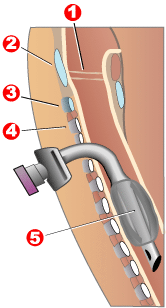Tracheotomy
surgical procedure creating an incision through thyrohyoid membrane to access the trachea
Tracheotomy and tracheostomy is a surgery on the neck to open a direct path by cutting a hole in the trachea (windpipe). They are performed by paramedics, veterinarians, emergency physicians, and surgeons. Both surgical and percutaneous techniques are now widely used.

1 - Vocal cords
2 - Thyroid cartilage
3 - Cricoid cartilage
4 - Tracheal cartilages
5 - Balloon cuff
Tracheostomy was written about in ancient Egyptian tablets,[1] but, in the 12th century, Ibn Zuhr described the first correct tracheotomy operation for people who were suffocating (could not breathe).[2] The current tracheostomy was described in 1909 by Chevalier Jackson, an American doctor.
References
change- ↑ "Tracheostomy: Evolution of an Airway," Archived 2017-04-01 at the Wayback Machine Steven E. Sittig and James E. Pringnitz, AARC Times, February 2001.
- ↑ Prof. Dr. Mostafa Shehata, "The Ear, Nose and Throat in Islamic Medicine", Journal of the International Society for the History of Islamic Medicine, 2003 (1): 2-5 [4].
Other websites
change- Tracheotomy Info
- Aaron's tracheostomy page
- How to perform an emergency tracheotomy Archived 2007-12-24 at the Wayback Machine (for information purposes only)
- RT Corner Educational Site for RT's and Nurses Archived 2017-09-24 at the Wayback Machine
- Pictures with video clips of tracheotomies
- "Book of Simplification Concerning Therapeutics and Diet" is an old book from 1497, in Latin, that talks about tracheotomies